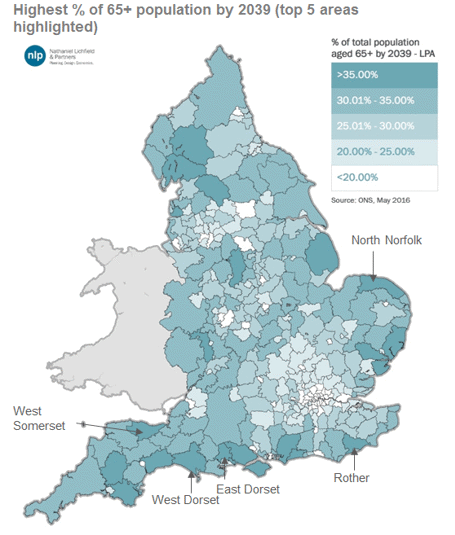NLP has undertaken analysis of how this ageing population picture varies across the different local authorities in England.
By 2039,
West Somerset will have a higher percentage of older persons than any other local authority in England, with 42% of the population over the age of 65. This is closely followed by
Rother (41%),
North Norfolk (40%),
West Devon (40%) and
East Dorset (39%). The fact that three of these authorities are in the South West, and all are in coastal areas away from major conurbations, reflects the spatial dimension to England’s ageing population.

Almost 10% of the population of each of these top five local authorities is expected to be over the age of 85 by 2039. This is close to double the projected national percentage of 5%.
These patterns of ageing population create challenges for the future – particularly for the planning system. The increase in older people nationally, with particular concentrations in specific locations will place greater emphasis on the need for the planning system to consider how best to:
Specifically in relation to the first and last points – the main emphasis in local plan- making is given to assessing the objectively assessed need for housing but often the specific requirement emerging for specialist older person’s accommodation is not then fully investigated. Moving forward, understanding these issues, considering the different housing types needed by older people and responding to these needs will become critical.
Building standard types of housing is necessary but this will not solve this crisis – we need to make sure we provide different forms of housing that meet the needs of all sections of society. Whilst specialist older person’s housing won’t be what every older person chooses – evidence suggests that currently older people are not even benefiting from such a choice.
A report by the Think-Tank DEMOS in 2013 described the chronic undersupply of housing for older people as
“the UK’s next housing crisis”. It stated that only 2% of the UK’s housing stock was dedicated retirement housing – far less than in most other countries with comparable populations of older people. Similar themes are also referenced in the recently published
HAPPI 3 Report (June 2016) - which reported that the number of homes built specifically for older people each year has fallen from 30,000 in the 1980s to fewer than 8,000 in recent years.
The evidence clearly suggests we have problem. We are failing to deliver housing for older people. In addition to the obvious social benefits of providing such housing, there are other lost opportunities too. Provision of specialist older person’s housing can help ‘free-up’ previously under-occupied family housing, thereby encouraging more fluidity within the wider housing market and helping to ensure that the needs of the wider population can be better met by existing stock. In addition, such development also delivers significant economic benefits and investment which is being lost as a result of a failure to ensure adequate supply.
The publication of this latest projection data underlines the urgency with which the housing needs of older people should be taken into account. The planning system will remain the key delivery mechanism for this future housing. The sooner it can start to proactively consider and deal with these issues the better.
NLP has re-launched its CAREpacity toolkit which aims to provide a helping hand to developers seeking to deliver housing for older people.
For more information on CAREpacity please
see our flyer or contact NLP directly.




